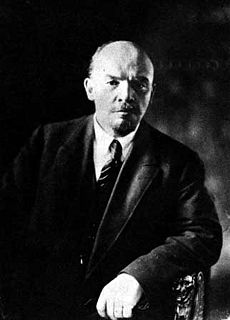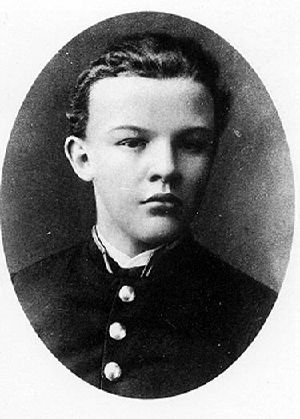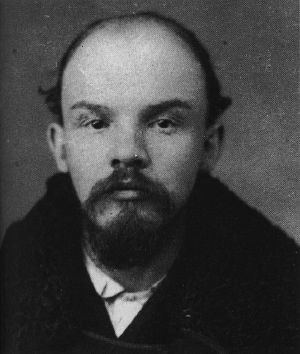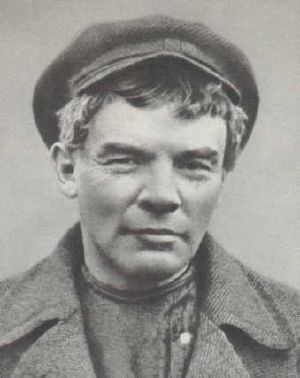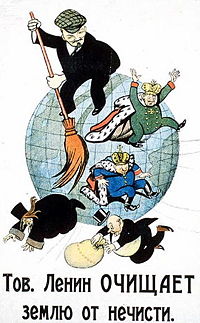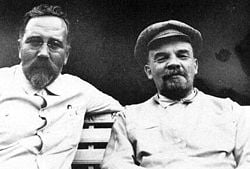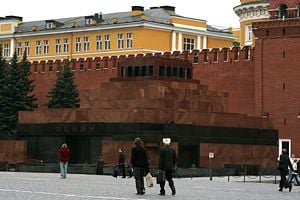Difference between revisions of "Vladimir Lenin" - New World Encyclopedia
| Line 80: | Line 80: | ||
After a failed [[July Days|Bolshevik rising in July]], Lenin fled to Finland for safety. He returned in October, inspiring an armed revolution with the slogan "All Power to the Soviets!" against the [[Russian Provisional Government, 1917|Provisional Government]]. His ideas of government were expressed in his essay "[[State and Revolution]]" [http://www.marxists.org/archive/lenin/works/1917/staterev/index.htm], which called for a new form of government based on workers' councils, or [[soviet (council)|soviets]] elected and revocable at all moments by the workers who were in turn to subordinate to their representatives. | After a failed [[July Days|Bolshevik rising in July]], Lenin fled to Finland for safety. He returned in October, inspiring an armed revolution with the slogan "All Power to the Soviets!" against the [[Russian Provisional Government, 1917|Provisional Government]]. His ideas of government were expressed in his essay "[[State and Revolution]]" [http://www.marxists.org/archive/lenin/works/1917/staterev/index.htm], which called for a new form of government based on workers' councils, or [[soviet (council)|soviets]] elected and revocable at all moments by the workers who were in turn to subordinate to their representatives. | ||
| + | October 26 1917 soviet government issued decree of peace (withdrawal from the war), decree of land (all the land became a property of the state and was to be passed over to peasantry free of charge), declaration of peoples rights (Russia became a classless society and every nation had a right of secession from Russia) | ||
<br style="clear:both" /> | <br style="clear:both" /> | ||
| Line 117: | Line 118: | ||
According to Orlando Figes, Lenin had always been an advocate of "mass terror against enemies of the revolution" and was open about his view that the proletarian state was a system of organized violence against the capitalist establishment. Figes also claims that the terror, while encouraged by the Bolsheviks, had its roots in a popular anger against the privileged. <ref>A Peoples Tragedy, pp 524-5</ref> When in late 1918 Kamenev and Bukharin tried to curb the "excesses" of the Cheka, it was Lenin who defended it.<ref> Figes p 649</ref> Lenin remained an enthusiastic advocate of mass terror. In 1922, on his instigation, some 8000 priests and laymen were executed, following an uprising by the clergy in the textile town of Shuia. | According to Orlando Figes, Lenin had always been an advocate of "mass terror against enemies of the revolution" and was open about his view that the proletarian state was a system of organized violence against the capitalist establishment. Figes also claims that the terror, while encouraged by the Bolsheviks, had its roots in a popular anger against the privileged. <ref>A Peoples Tragedy, pp 524-5</ref> When in late 1918 Kamenev and Bukharin tried to curb the "excesses" of the Cheka, it was Lenin who defended it.<ref> Figes p 649</ref> Lenin remained an enthusiastic advocate of mass terror. In 1922, on his instigation, some 8000 priests and laymen were executed, following an uprising by the clergy in the textile town of Shuia. | ||
| + | |||
| + | Ironically, before revolution Tsarist secret police viewed Socialist Revolutionary Party as the most radical group supporting terrorist tactics, while Bolshevics were viewed as a bunch of theorizing intellectuals. | ||
==Russian Communist Party and civil war== | ==Russian Communist Party and civil war== | ||
Revision as of 21:38, 24 October 2006
| Office | Chairman of the Council of People's Commissars |
| Term of office | 1917–1924 |
| Predecessor | Alexander Kerensky |
| Successor | Alexey Ivanovich Rykov |
| Date of birth | April 22, 1870 |
| Place of birth | Simbirsk, Russia |
| Date of death | January 21, 1924 |
| Place of death | Moscow, Russia |
| Profession | Revolutionary, Politician |
| Political party | Bolshevik Party |
Vladimir Ilyich Ulyanov, better known by the name Lenin ▶ (b. April 22, 1870 – d. January 24, 1924), was a Russian socialist politician, the main leader of the October Revolution and the first head of the Soviet Russia.
Early life
Born in Simbirsk, Russian Empire (now Ulyanovsk), Lenin was the son of Ilya Nikolaevich Ulyanov (1831–1886), a Russian civil service official who worked for progressive democracy and free universal education in Russia, and his liberal wife Maria Alexandrovna Ulyanova (1835–1916). They were raising their children in the spirit of denyal of aytocracy and religion. All of their children, exept early deceased Olga, became professional revolutionaries. The family was of mixed ethnic ancestry. "Lenin's antecedents were Russian, Kalmyk, Jewish, German and Swedish, and possibly others".[1] Lenin was baptized into the Russian Orthodox Church.
Two tragedies occurred early in his life. The first occurred when his father died of a cerebral hemorrhage in 1886. In May 1887, his eldest brother Alexander Ulyanov was hanged for participation in a terrorist plot (bomb attack) threatening the life of Tsar Alexander III; his sister Anna, who was with Alexander at the time of his arrest, was banished to the small town of Kokuchkino near Karzan. This radicalized Lenin. His official Soviet biographies have this event as central to his revolutionary exploits. A famous painting by Belousov, "We Will Follow a Different Path", reprinted in millions of Soviet textbooks, depicted young Lenin and his mother grieving the loss of his elder brother. The phrase "We will follow a different path" meant that Lenin chose a Marxist approach for a popular revolution, instead of anarchistic, individualistic methods. As Lenin became interested in Marxism, he got involved in student protests and was subsequently arrested. He was then expelled from Kazan University. He continued to study independently and by 1891 had earned a license to practice law[2]. He also distinguished himself in Latin and Greek, and also learned German, French and English. Lenin is also accredited with translating the Communist Manifesto into Russian in the period between being expelled from the University and obtaining his license to practice law.
Philosophical work
Lenin was an author of several theoretical works in philosophy such as Materialism and Empiriocriticism which became fundamential in Marxist-Leninist philosophy.
Revolutionary
Lenin worked for some years in Samara, Russia, then in 1893 moved to St Petersburg. Rather than settling into a legal career, he became more involved in revolutionary propaganda efforts and the study of Marxism. On December 7 1895, he was arrested and held by authorities for 14 months, then exiled to the village of Shushenskoye in Siberia.
In July 1898, he married Nadezhda Krupskaya, who was a socialist activist. In April 1899, he published the book The Development of Capitalism in Russia [3]. In 1900 his exile ended and he travelled in Russia and elsewhere in Europe. He lived in Zurich, Geneva (where he lectured and studied at Geneva State University), Munich, Prague, Vienna, Manchester and London, and during his exile co-founded the newspaper Iskra (Russian for the spark - the spark that ignites the flame of communism) with Julius Martov, later a leading opponent. He also wrote several articles and books related to the revolutionary movement. At this period, he started using various aliases, finally settling upon Lenin.
He was active in the Russian Social Democratic Labour Party (RSDLP; РСДРП in Russian), and in 1903 he led the Bolshevik (from Russian "bolshiy" for "bigger" - bigger part of RSDLP supported his concept of strict discipline and centralisation) faction after a split with the Mensheviks (correspondingly, from Russian "menshiy" for "smaller" - the smaller part was of democratic approach) that was partly inspired by his pamphlet What is to be Done?. This is said to be one of the most influential pamphlets in pre-revolutionary Russia, with Lenin himself claiming that 3 out of 5 workers had read it or had had it read to them. [4]. In 1906 he was elected to the Presidium of the RSDLP. In 1907, he moved to Finland for security reasons. He continued to travel in Europe and participated in many socialist meetings and activities, including the Prague Party Conference of 1912 and the Zimmerwald Conference of 1915. When Inessa Armand left Russia and settled in Paris, she met Lenin and other Bolsheviks living in exile, and it is believed that she became Lenin's lover during this time. Lenin later moved to Switzerland.
When the First World War began in 1914 and the large Social Democratic parties of Europe (at that time self-described as Marxist), including luminaries such as Karl Kautsky, supported their various countries' war efforts, Lenin was shocked, at first refusing to believe that the German Social Democrats had voted for war credits. This led him to a final split with the Second International, which was composed of these parties. Lenin adopted the position that what he described as an 'imperialist war' should be turned into a civil war between the classes.
With the advance of the war industrial and cultural backwardness of Russia became evident, financial system came to complete decline, army suffered defeat after defeat, and the whole country came to the brink of social disaster. Which came in the form of February Revolution of 1917.
After the 1917 February Revolution in Russia and the overthrow of Tsar Nicholas II, Lenin knew he needed to travel back to Russia as soon as possible. But he was isolated in neutral Switzerland as the First World War was raging. The Swiss communist Fritz Platten, however, managed to negotiate with the German government for Lenin and his company to travel through Germany by train. The German government hoped Lenin would cause political unrest back in Russia, which would help to end the war on the Eastern front. Once through Germany, Lenin continued by ferry to Sweden, and the rest of the trip through Scandinavia was arranged by the Swedish communists Otto Grimlund and Ture Nerman.
On April 16, 1917, arrived in Petrograd and took a leading role within the Bolshevik movement, publishing the April Theses [5], which called for an uncompromising opposition to the provisional government. Initially, Lenin isolated his party through this lurch to the left. However, this uncompromising stand meant that the Bolsheviks were to become the obvious home for all those who became disillusioned with the provisional government, and with the "luxury of opposition" the Bolsheviks did not have to assume responsibility for any policies implemented by the government.[6]
Meanwhile, Aleksandr Kerensky and other opponents of the Bolsheviks accused Lenin of being a paid German agent. In response Leon Trotsky, formerly a Menshevik, but now moving closer to the Bolshevik position, made a defensive speech on July 17, saying: "An intolerable atmosphere has been created, in which you as well as we are choking. They are throwing dirty accusations at Lenin and Zinoviev. Lenin has fought thirty years for the revolution. I have fought twenty years against the oppression of the people. And we cannot but cherish a hatred for German militarism. ... I have been sentenced by a German court to eight months’ imprisonment for my struggle against German militarism. This everybody knows. Let nobody in this hall say that we are hirelings of Germany." [1]
After a failed Bolshevik rising in July, Lenin fled to Finland for safety. He returned in October, inspiring an armed revolution with the slogan "All Power to the Soviets!" against the Provisional Government. His ideas of government were expressed in his essay "State and Revolution" [2], which called for a new form of government based on workers' councils, or soviets elected and revocable at all moments by the workers who were in turn to subordinate to their representatives.
October 26 1917 soviet government issued decree of peace (withdrawal from the war), decree of land (all the land became a property of the state and was to be passed over to peasantry free of charge), declaration of peoples rights (Russia became a classless society and every nation had a right of secession from Russia)
Head of the Soviet state
On November 8, Lenin was elected as the Chairman of the Council of People's Commissars by the Russian Soviet Congress.
"Communism is Soviet power plus the electrification of the entire country,"[7] Lenin said, emphasizing the importance of bringing electricity to all corners of Russia and modernizing industry and agriculture. "We must show the peasants that the organization of industry on the basis of modern, advanced technology, on electrification which will provide a link between town and country, will put an end to the division between town and country, will make it possible to raise the level of culture in the countryside and to overcome, even in the most remote corners of land, backwardness, ignorance, poverty, disease, and barbarism."[8] He was very concerned about creating a free universal health care system for all, the emancipation of women, and teaching the illiterate Russian people to read and write. [9] But first and foremost, the new Bolshevik government needed to take Russia out of the World War.
Faced with the threat of a continuing German advance eastwards, Lenin argued that Russia should immediately sign a peace treaty. Other Bolshevik leaders, such as Bukharin, advocated continuing the war as a means of fomenting revolution in Germany. Trotsky, who led the negotiations, advocated an intermediate position, of "No War, No Peace", calling for a peace treaty only on the conditions that no territorial gains on either side be consolidated. After the negotiations collapsed, the Germans renewed their advance, resulting in the loss of much of Russia's western territory. As a result of this turn of events, Lenin's position consequently gained the support of the majority in the Bolshevik leadership. On March 3 1918, Lenin removed Russia from World War I by agreeing to the Treaty of Brest-Litovsk, under which Russia lost significant territories in Europe.
After the Bolsheviks lost the elections for the Russian Constituent Assembly, they used the Red Guards to shut down the first session of the Assembly on January 19. Later, the Bolsheviks organized a counter-Assembly, the third Congress of Soviets, arranged so that they and their allies held over 90% of the seats [10]. This marked the beginning of the steady elimination from political life of all factions and parties whose views did not correspond to the position taken by Lenin and the Bolsheviks.
The Bolsheviks formed a coalition government with the left wing of the Socialist Revolutionaries. However, their coalition collapsed after the Social Revolutionaries opposed the Brest-Litovsk treaty, and joined other parties in seeking to overthrow the Bolshevik government. Lenin responded to these efforts by a policy of wholesale persecution, which included jailing some of the members of the opposing parties.
Creation of the politburo and secret police
From early 1918, Lenin campaigned for a single, democratically accountable individual to be put in charge of each enterprise, contrary to most conceptions of workers' self-management, but absolutely essential for efficiency and expertise. As S.A. Smith wrote: "By the end of the civil war, not much was left of the democratic forms of industrial administration promoted by the factory committees in 1917, but the government argued that this did not matter since industry had passed into the ownership of a workers' state."
To protect the newly-established Bolshevik government from counterrevolutionaries and other political opponents, the Bolsheviks created a secret police, the Cheka (from Russian "чрезвычайный комитет" or ЧК for "extraordinary committee"). The Bolsheviks had planned to hold a trial for the former Tsar, but in August 1918, when the White Army was advancing on Yekaterinburg (where the once royal family was being held), Sverdlov acceded to the request of the local Soviet to execute the Tsar right away, rather than having him taken by the Whites. In the event both the Tsar and the rest of his immediate family was executed, though whether this was a decision of the central government or the local Soviet remains the subject of historical dispute. (For the most recent and most extensive investigation into these murky events and into the question of who was ultimately responsible for the killings see The Fate of the Romanovs (2003) by Greg King and Penny Wilson [3].)
Assassination attempt
On January 14, 1918, an assassination attempt was made against Lenin’s car in Petrograd by unknown gunmen. Lenin and Fritz Platten were in the back of the car together, after having given a public speech. When the shooting started, "Platten grabbed Lenin by the head and pushed him down. ... Platten’s hand was covered in blood, having been grazed by a bullet as he was shielding Lenin."[11]
On August 30 1918, Fanya Kaplan, a member of the Socialist Revolutionary Party, approached Lenin after he had spoken at a meeting and was on the way to his car. She called out to Lenin, who turned to answer. She immediately fired three shots, two of which struck him in the shoulder and lung. Lenin was taken to his apartment in the Kremlin, refusing to venture to a hospital since he believed that other assassins would be waiting there. Doctors were summoned but decided that it was too dangerous to remove the bullets. Lenin eventually recovered, though his health declined from this point. It is believed that the incident contributed to his later strokes.
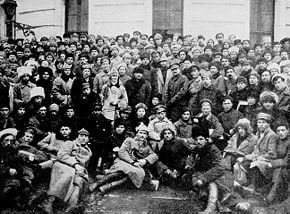
The Communist government responded to the assassination attempt, and to the increasingly mobilizing anti-communist offensive of which it was a component, with what they termed the Red Terror. Tens of thousands of real and perceived enemies of the Revolution, many accused of actively conspiring against the Bolshevik government, were executed or put in labor camps. The Red Terror coincided with the escalation of the Civil War and the implemenatation of a policy known as War Communism. Amongst other things this involved forced grain requsitions from the peasantry, and became a cause of widespread famine. [4].
According to Orlando Figes, Lenin had always been an advocate of "mass terror against enemies of the revolution" and was open about his view that the proletarian state was a system of organized violence against the capitalist establishment. Figes also claims that the terror, while encouraged by the Bolsheviks, had its roots in a popular anger against the privileged. [12] When in late 1918 Kamenev and Bukharin tried to curb the "excesses" of the Cheka, it was Lenin who defended it.[13] Lenin remained an enthusiastic advocate of mass terror. In 1922, on his instigation, some 8000 priests and laymen were executed, following an uprising by the clergy in the textile town of Shuia.
Ironically, before revolution Tsarist secret police viewed Socialist Revolutionary Party as the most radical group supporting terrorist tactics, while Bolshevics were viewed as a bunch of theorizing intellectuals.
Russian Communist Party and civil war
- Further information: On the Allies invasion of Russia: Polar Bear Expedition , North Russia Campaign, American Expeditionary Force Siberia
In March 1919, Lenin and other Bolshevik leaders met with revolutionary socialists from around the world and formed the Communist International. Members of the Communist International, including Lenin and the Bolsheviks themselves, broke off from the broader socialist movement. From that point onwards, they would become known as communists. In Russia, the Bolshevik Party was renamed the "Russian Communist Party (Bolsheviks)," which eventually became the CPSU.
Meanwhile, the civil war raged across Russia. A wide variety of political movements and their supporters took up arms to support or overthrow the Soviet government. Although many different factions were involved in the civil war, the two main forces were the Red Army (communists) and the White Army. Foreign powers such as France, Britain, the United States and Japan also intervened in this war (on behalf of the White Army), though their impact was peripheral at best. Eventually, the more organizationally proficient Red Army, led by Leon Trotsky, won the civil war, defeating the White Russian forces and their allies in 1920. Smaller fights, however, continued for several more years.
Both White and Red Army forces, during this tumultuous time of war and revolution, "behaved with great brutality and cruelty in areas they controlled. Towns were burned, property destroyed or stolen, peasant farmers' crops and livestock taken by force — if people objected, they faced torture and execution." [5] Far from being dictated by military necessity, Brovkin has argued that this level of terror was highly counterproductive. Alienation of the population behind the lines can explain, according to him, both red and white defeats during the civil war. [14]
In late 1919, successes against the White Russian forces convinced Lenin that it was time to spread the revolution to the West, by force if necessary. When the newly independent Second Polish Republic began securing its eastern territories annexed by Russia in the partitions of Poland in the late 18th century, it clashed with Bolshevik forces for dominance in these areas, which led to the outbreak of the Polish-Soviet War in 1919. With the revolution in Germany and the Spartacist League on the rise, Lenin viewed this as the perfect time and place to "probe Europe with the bayonets of the Red Army." Lenin saw Poland as the bridge that the Red Army would have to cross in order to link up the Russian Revolution with the communist supporters in the German Revolution, and to assist other communist movements in Western Europe. However the defeat of Soviet Russia in the Polish-Soviet War invalidated these plans.
Lenin was a harsh critic of imperialism. In 1917 he declared the unconditional right of self-determination and separation for national minorities and oppressed nations, usually defined as those nation-states that were previously subject to capitalist imperial control. However, when the Russian Civil War was won he used military force to assimilate the newly independent nations Armenia, Georgia, and Azerbaijan, arguing that the inclusion of those countries into the newly emerging Soviet government would shelter them from capitalist imperial ambitions. [6]
The long years of war, the Bolshevik policy of War communism, the Russian famine of 1921, and the encirclement of hostile governments took their toll on Russia, however, and much of the country lay in ruins. There were many peasant uprisings, the largest being the Tambov rebellion. After an uprising by the sailors at Kronstadt in March 1921, Lenin replaced the policy of War Communism with the New Economic Policy (NEP), in a successful attempt to rebuild industry and especially agriculture. The new policy was based on a recognition of political and economic realities such as good old private business, though it was intended merely as a tactical retreat from the socialist ideal. The whole policy was later reversed by Stalin.
Lenin's stance on anti-Semitism
- In a radio speech in 1919, Lenin stated: - - "The Tsarist police, in alliance with the landowners and the capitalists, organized pogroms against the Jews. The landowners and capitalists tried to divert the hatred of the workers and peasants who were tortured by want against the Jews. ... Only the most ignorant and downtrodden people can believe the lies and slander that are spread about the Jews. ... It is not the Jews who are the enemies of the working people. The enemies of the workers are the capitalists of all countries. Among the Jews there are working people, and they form the majority. They are our brothers, who, like us, are oppressed by capital; they are our comrades in the struggle for socialism. ... Shame on accursed Tsarism which tortured and persecuted the Jews. Shame on those who foment hatred towards the Jews, who foment hatred towards other nations." [7] - - While Lenin remained opposed to outward forms of anti-semitism (and all forms of racism), allowing Jewish people to rise to the highest offices in both party and state, the record of his government in this regard was highly uneven. The 1921 campaign against religion saw the seizure of many synagogues. Lenin, moreover, was aware of pogroms carried out by units of the Red Army during the war with Poland, though the whole issue was effectively ignored. It has been said of this by the Russian historian Dimitri Volkogonov that "While condemning ant-semitism in general, Lenin was unable to analyse, let alone eradicate, its prevalence in Soviet society." - - However, according to Jewish historian Zvi Gitelman: "Never before in Russian history - and never subsequently has a government made such an effort to uproot and stamp out antisemitism". - [15]
Later life
Lenin's health had already been severely damaged by the strains of revolution and war. The assassination attempt earlier in his life also added to his health problems. The bullet was still lodged in his neck, too close to his spine for medical techniques of the time to remove. In May 1922, Lenin had his first stroke. He was left partially paralyzed on his right side, and his role in government declined. After the second stroke in December of the same year, he resigned from active politics. In March 1923, he suffered his third stroke and was left bedridden for the remainder of his life, no longer able to speak.
After his first stroke, Lenin dictated several papers regarding the government to his wife. Most famous of these is Lenin's Testament, which among other things criticized top-ranking communists, especially Joseph Stalin. Of Stalin, who had been the Communist Party's general secretary since April 1922, Lenin said that he had "unlimited authority concentrated in his hands" and suggested that "comrades think about a way of removing Stalin from that post." Upon Lenin's death, his wife mailed his Testament to the central committee, to be read at the 13th Party Congress in May 1924. However, because the will criticized all of the most prominent figures in the central committee: Zinoviev, Kamenev, Bukharin and Stalin, the committee had a vested interest in not releasing the will to the wider public. The central committee justified this by stating that Lenin had been mentally ill in his final years and, as such, his final judgments were not to be trusted. Lenin's Testament was first officially published in 1926 in the United States by Max Eastman. [8]
Lenin died on January 21 1924, aged 53. Rumors of Lenin having syphilis sprang up shortly after his death. The official cause given for Lenin's death was cerebral arteriosclerosis, or a fourth stroke. But out of the 27 physicians who treated him, only eight signed onto that conclusion in his autopsy report. Therefore, several other theories regarding his death have been put forward.
Documents released after the fall of the U.S.S.R., along with memoirs of Lenin's physicians, suggest that Lenin was treated for syphilis as early as 1895. Documents suggest that Alexei Abrikosov, the pathologist in charge of the autopsy, was ordered to prove that Lenin did not die of syphilis. Abrikosov did not mention syphilis in the autopsy; however, the blood-vessel damage, the paralysis and other incapacities he cited are typical of syphilis. Upon a second release of the autopsy report, none of the organs, major arteries, or brain areas usually affected by syphilis were cited.
In 1923, Lenin's doctors treated him with Salvarsan, the only drug at the time specifically used to treat syphilis, and potassium iodide, which was customary at the time in treating the disease.
Although he might have had syphilis, he had no visible lesions anywhere on his body that normally accompany the later stages of the disease. Most historians still agree that the most likely cause of his death was a stroke induced by the bullet still lodged in his neck from the assassination attempt.
The city of Petrograd was renamed Leningrad in his honor three days after Lenin's death. This remained the name of the city until the collapse and liquidation of the Soviet Union in 1991, when it reverted to its original name, St Petersburg.
During the early 1920s the Russian movement of cosmism was quite popular and there was an intent to cryonically preserve Lenin's body in order to revive him in the future. Necessary equipment was purchased abroad, but for a variety of reasons the plan was not realized. Instead his body was embalmed and placed on permanent exhibition in the Lenin Mausoleum in Moscow on January 27 1924.
After death
Lenin's preserved body is on permanent display at the Lenin Mausoleum in Moscow. Because of Lenin's unique role in the creation of the first Communist state, and despite his expressed wish shortly before his death that no memorials be created for him, his character was elevated over time to the point of near religious reverence. By the 1980s, every major city in the Soviet Union had a statue of Lenin in its central square, either a Lenin street or a Lenin Square near the center, and often 20 or more smaller statues and busts throughout its territory. Collective farms, medals, hybrids of wheat, and even an asteroid were named after him. Children were taught stories about "granddaddy Lenin" while they were still in kindergarten.
Since the fall of the Soviet Union, the level of reverence for Lenin in post-Soviet republics has gone down considerably, but he is still considered an important figure by the generations who grew up during the Soviet period. [9] Most statues of Lenin have been torn down in Eastern Europe, but many still remain in Russia. The city of Leningrad returned to its original name, St Petersburg, but the surrounding Leningrad Oblast still carries his name. The citizens of Ulyanovsk, Lenin's birthplace, have so far resisted all attempts to revert its name to Simbirsk. The subject of interring Lenin's body has been a recurring topic for the past several years in Russia.
Lenin's brain study
Lenin's brain was removed before his body was embalmed. The Soviet government commissioned the well-known German neuroscientist Oskar Vogt to study Lenin's brain and to locate the precise location of the brain cells that are responsible for "genius". The study was performed in Vladimir Bekhterev's Institute of the Brain. Vogt published a paper on the brain in 1929 where he reported that while the brain was discolored, shrunken, and showed "widespread areas of softening"[10], some pyramidal neurons in the third layer of Lenin's cerebral cortex were very large. However the conclusion of its relevance to genius was contested. Vogt's work was considered unsatisfactory by the Soviets. Further research was continued by the Soviet team, but the work on Lenin's brain was no longer advertised. Contemporary anatomists are no longer convinced that morphology alone can determine the functioning of the brain.
Censorship of Lenin in the Soviet Union
Lenin's writings were carefully censored under the Soviet regime after his death. In the early 1930s, it became accepted dogma under Stalin to assume that neither Lenin nor the Central Committee could ever be wrong. Therefore, it was necessary to remove evidence of situations where they had actually disagreed, since in those situations it was impossible for both to have been right at the same time. Trotsky was a particularly vocal critic of these practices, which he saw as a form of deification of a mere human being who could, and did, make mistakes. [11] Later, even the fifth complete Soviet edition of Lenin's works (published in 55 thick volumes between 1958 and 1965) left out parts that either contradicted dogma or showed their author in too poor a light. [12]
See also
- Leningrad
- List of statues of Lenin
- Russian Revolution of 1917
- Leninism
- Anti-Leninism
Notes
- ↑ Dimitri Volkogonov "Lenin - A New Biography", page 8. ISBN 0-02-933435-7
- ↑ Robert Service "Lenin: A Biography" ISBN 0-330-49139-3
- ↑ Development of Capitalism in Russia
- ↑ What is to be done?
- ↑ April Theses
- ↑ Read, Christopher. From Tsar to Soviets. p. 151-153
- ↑ Lenin "Collected Works", vol. 31, page 516.
- ↑ Lenin "Collected Works", vol. 30, page 335.
- ↑ Archive of Lenin's works
- ↑ http://www.gmu.edu/departments/economics/bcaplan/museum/his1d.htm
- ↑ Dmitri Volkogonov "Lenin: A New Biography", page 229. ISBN 0-02-933435-7
- ↑ A Peoples Tragedy, pp 524-5
- ↑ Figes p 649
- ↑ Behind the Front Lines of the Civil War: Political Parties and Social Movements in Russia, 1918-1922
- ↑ Zvi Gutelman (1986) 'Soviet Antisemitism and its perception by Soviet Jews', in Curtis, M. (ed) Antisemitism in the Contemporary World: 189-90
Further reading
- C.L.R. James, Every Cook Can Govern
- Leon Trotsky, Lenin
- Robert Service, Lenin: A Biography
- Revolution at the Gates: A Selection of Writings from February to October 1917 by V. I. Lenin, Slavoj Zizek (Editor), Verso Books, ISBN 1-85984-661-0
- Louis Fischer, The Life of Lenin, ISBN B00005W8VC (This is an Amazon.com number; many other options are available through ABE)
- Leszek Kolakowski, Main Currents of Marxism
- John Gooding, Socialism In Russia: Lenin and His Legacy, 1890–1991
- Anton Pannekoek, Lenin as Philosopher
- Dmitri Volkogonov, Lenin: A New Biography
- Robert Tucker, "The Lenin Anthology"
- Lenin Internet Archive Biography includes interviews with Lenin and essays on the leader
- Robert Payne, The Life And Death Of Lenin
- David Shub, "Lenin" , Doubleday, 1948 [new material in Pelican Original version, 1965]
- Arnold Toynbee. "A Centenary View of Lenin", International Affairs, Vol. 46, No. 3. (Jul., 1970), pp. 490–500.
- Tony Cliff, "Lenin: Building the Party", Bookmarks, 1986
External links
- Marxists.org Lenin Internet Archive — Extensive compendium of writings, a biography, and many photographs
- Article on Lenin written by Trotsky for the Encyclopedia Britannica
- Reminiscences of Lenin by N. K. Krupskaya
- Impressions of Soviet Russia, by John Dewey
- Information on Lenin's Grave
- The Lenin Museum in Tampere, Finland
- The Unknown Lenin: From the Secret Archives
- Lenin and the First Communist Revolutions
Selected works
- The Development of Capitalism in Russia
- What is to be Done? [13]
- One Step Forward, Two Steps Back
- Two Tactics of Social-Democracy in the Democratic Revolution
- Materialism and Empirio-Criticism
- The Right of Nations to Self-Determination
- Imperialism, the Highest Stage of Capitalism
- The State and Revolution [14]
- The Proletarian Revolution and the Renegade Kautsky
- Left-Wing Communism: An Infantile Disorder [15]
- Lenin's Testament
- Lenin's last letter to Stalin
| Preceded by: Aleksandr Kerensky (as Head of the Provisional Government of 1917) |
Chairman of the Council of People's Commissars 1917—1924 |
Succeeded by: Alexey Ivanovich Rykov |
Template:USSRpremier
| Persondata | |
|---|---|
| NAME | Lenin, Vladimir Ilyich |
| ALTERNATIVE NAMES | Vladimir Illyich Ulyanov, Владимир Ильич Ульянов (Ленин) (Russian) |
| SHORT DESCRIPTION | Russian politician, led October Revolution |
| DATE OF BIRTH | 22 April 1870 |
| PLACE OF BIRTH | Simbirsk, Russia |
| DATE OF DEATH | 21 January 1924 |
| PLACE OF DEATH | Moscow, Russia |
Credits
New World Encyclopedia writers and editors rewrote and completed the Wikipedia article in accordance with New World Encyclopedia standards. This article abides by terms of the Creative Commons CC-by-sa 3.0 License (CC-by-sa), which may be used and disseminated with proper attribution. Credit is due under the terms of this license that can reference both the New World Encyclopedia contributors and the selfless volunteer contributors of the Wikimedia Foundation. To cite this article click here for a list of acceptable citing formats.The history of earlier contributions by wikipedians is accessible to researchers here:
The history of this article since it was imported to New World Encyclopedia:
Note: Some restrictions may apply to use of individual images which are separately licensed.
